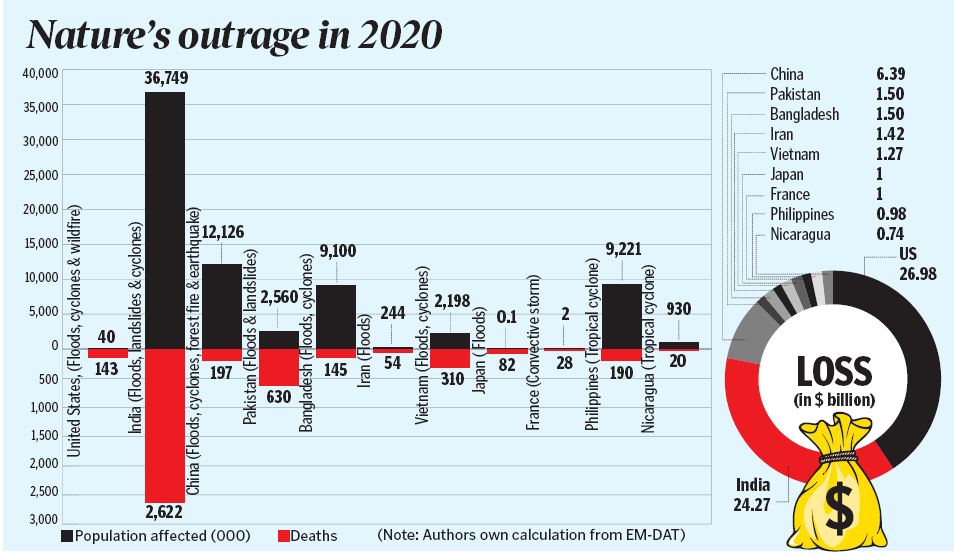Fury and cost of natural disasters
India is the most vulnerable and severely affected nation due to natural disasters in South Asia

2020 was an unfortunate year for the world, primarily due to the Covid-19 pandemic. The pandemic has adversely affected human health along with different sectors of the economy. Though the impact of Covid-19 has been widely covered by the media globally, other relevant news did not find adequate space. Natural disaster — floods, earthquakes, cyclones, bushfires, hurricanes and heatwaves — is one such.
Based on the geo-climatic and socioeconomic vulnerability condition, a few countries are more vulnerable to specific natural disasters than others. Frequent natural disasters have resulted in human casualty and loss of physical capital.
Moreover, natural disasters also adversely affect different sectors of the economy and livelihoods of millions of poor people in developing nations. During the Covid-19 pandemic, natural disasters also increased the government’s fiscal pressure through rehabilitation and relief distribution measures.
Across the World
According to the Emergency Events Database (EM-DAT), around 350 natural disasters occurred in 118 countries in 2020. Among these, floods occurred the most in the world – 195 times, followed by cyclones (104), landslides (18), earthquake (14), wildfire (8), drought (6) and volcanic activity (4).
Besides, around 8,274 people were killed, and 99.8 million were affected due to natural disasters. Flood killed 5,532 people, followed by cyclone (1,505), landslide (975), earthquake (188) and wildfire (71). Regarding the country-wise death caused by such disasters, around 2,622 people were killed in India, which has the highest fatalities among the nations, followed by Pakistan (630), Vietnam (310), China (197), The Philippines (190) and France (28). See infographics.
Moreover, natural disasters caused extensive damage to public and private properties. In 2020, the US lost around $26.98 billion due to natural disasters, followed by India ($24.27 billion), China ($6.39 billion), Pakistan and Bangladesh ($1.5 billion), respectively, Iran ($1.42 billion) and Nicaragua ($0.74 billion). Also, cyclones were the most expensive disasters in 2020 at $14.3 billion followed by wildfire ($13 billion), flood ($10 billion), earthquakes ($0.5 billion) and volcanic activity ($0.1 billion).
India Most Vulnerable
In South Asia, India is the most vulnerable and severely affected nation by natural disasters due to its geographical location and socioeconomic condition. According to the EM-DAT, 13 natural disasters such as floods, cyclones, and landslides killed 2,622 people in India in 2020 while 36.7 million were affected.
Around six floods occurred in 13 States in India that killed 2,410 people, costing $10 billion. Moreover, 18.6 million people were affected due to floods. During this period, India also faced four cyclones, namely Amphan, Nisarga, Nivar, and Burevi, that killed 121 people, and caused damage of $14.26 billion. Moreover, 91 people were killed due to landslides.
According to the Accidental Deaths & Suicides in India (ADSI) report, around 2,876 people were killed due to lightning in different States in India in 2019. In recent years, lighting has been the most lethal disaster in India. In 2020, Uttar Pradesh and Bihar were severely affected due to lightning compared with other States.

Minimising Disasters
Frequent natural disasters affect the livelihood of millions of rural households. Due to floods there is a reduction in agricultural wages and this adversely affect the rural households’ economic conditions. Natural disasters also reduce the per capita growth, adversely affecting the country’s economic growth.
To mitigate disaster impact in the Indian States, the strategies of both Central and State governments should focus on suitable long-term disaster risk reduction policies such as building disaster-resilient infrastructure, afforestation measures, monitoring and constructing river embankments, installing flood and cyclone warning systems in flood and cyclone-prone districts.
The government also needs to provide brick houses to eligible beneficiaries living in low-lying areas. It should invest in constructing multipurpose cyclone and flood shelters in the coastal districts, which can help in reducing disaster fatalities in the future.
To minimise death due to lightning, installing lightning detecting warning system at the block level and creating awareness among the community will help. In this context, the Government of Odisha’s disaster management policies provide a good example to emulate. Odisha’s disaster management policies minimised the loss of lives from cyclones Fani and Amphan.
(Dr Parida is Research Fellow, Verghese Kurien Centre of Excellence, Institute of Rural Management Anand; Dr Grover is Assistant Professor in Economics, Shaheed Bhagat Singh College, University of Delhi; Views are personal)
Now you can get handpicked stories from Telangana Today on Telegram everyday. Click the link to subscribe.
Click to follow Telangana Today Facebook page and Twitter .
Related News
-
Revanth Reddy’s sinister designs to create rift in BRS will not work, says Harish Rao
-
Centuries and fiery spells highlight HCA Inter-school U-14 cricket in Hyderabad
-
Aadarsh Malik stars as Haryana bowl out Hyderabad in Vijay Merchant Trophy
-
HCA to host Telangana Inter-District T20 tournament from December 22
-
TikTok US operations secured after sale agreement with American investors
5 mins ago -
Bangladesh uprising leader Sharif Osman Hadi dies after shooting
14 mins ago -
Shilpa Shetty’s legal representative refutes reports of income tax raid
9 hours ago -
Sumit Nagal wins golden-point thriller as AOS Eagles shine in Bengaluru
9 hours ago -
India eye strong finish in final T20I against South Africa in Ahmedabad
9 hours ago -
BRS complaints of foul play over Neelibanda thanda Sarpanch election results
9 hours ago -
Ishan Kishan powers Jharkhand to maiden Syed Mushtaq Ali Trophy title
9 hours ago -
Cummins and Lyon put Australia on top in Adelaide Ashes Test
9 hours ago




